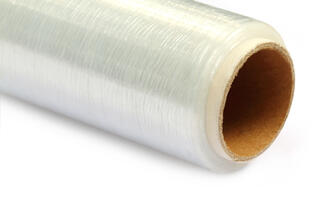 Every manufacturer has to contend with the challenge of keeping their products safe on the journey from the factory floor to the customer’s store.
Every manufacturer has to contend with the challenge of keeping their products safe on the journey from the factory floor to the customer’s store.
There are many factors that can make the simple-sounding task of delivering goods from point A to point B a veritable minefield of potential hazards, including:
- Cases separating from the pallet.
- Damage to cases from impacts with loose objects.
- Damage to products from moisture exposure.
- Damage to cases from UV exposure.
- Tampering with cases that results in loss of or damage to products.
Any one of the above issues can result in a loss of products, and thus profit, between the end of the manufacturing line and the successful delivery of goods.
Thankfully, there are ways to prevent the above issues, such as using stretch wrapping for your end-of-line packaging of products.
How Stretch Wrapping Helps
Stretch wrapping, as the name implies, takes a thin sheet of semi-elastic stretch film (usually linear low-density polyethylene) and stretches it over an object or group of objects. As the film stretches, its mechanical properties actually improve, increasing its resistance to punctures and tearing. Once wrapping is finished, the film’s elastic properties cause it to try to shrink, ensuring a tight wrap of the products within.
This layer of film makes sure that the products in a pallet all stay together securely, preventing cartons/containers from falling loose during the shipping process and becoming lost. Additionally, the film acts as a barrier that can protect bundles of products from:
- Impacts with other objects in shipping.
- UV radiation (if using UV-protective film).
- Exposure to dust, dirt, moisture, and other contaminants.
In short, stretch wrapping helps to make sure that your products survive the journey from your manufacturing floor to their final destination intact and ready to be accepted by your clients. This reduces shipment rejections and lost product claims, saving your company on materials and shipping costs while keeping clients happy with your product.
Types of Stretch Wrapping Machines
Before you start your search for a stretch wrapping machine, it’s important to know that there are several different types of these machines, from small, manually-operated models to large, fully automated units that can wrap large bundles of packages all at once.
Here’s a quick rundown of each level of wrapping automation:
- Manual Hand Wrapping- this method of stretch wrapping involves nearly 100% direct manual labor. Not only does the worker attach the stretch wrap to a pallet load, he or she then goes around the load until the process of wrapping has been completed. Of the methods of applying stretch wrap, this one is typically the most time and resource intensive, as human operators simply cannot stretch the wrap as much as a machine can, and take longer to apply the wrap.
- Semiautomatic Wrapping- in this method, a human operator takes the stretch wrap and attaches it to the load, then lets the machine take over from there. Once the load is wrapped, the operator cuts the film tail. While this process does require some manual labor, the operator can focus on other tasks while the machine is wrapping the load.
- Fully Automated Wrapping- these machines require virtually no human interaction at any phase of the wrapping process. These systems can automatically wrap a load, weigh down and cut the film tail, and move the wrapped load to the final staging area independent of a human operator.
The wrapping machines used in partial- or fully-automated processes can then be broken down into three primary types of machinery:
- Rotary Tower Machines- These machines have a specialized arm that rotates around the load being wrapped. These machines are preferred for heavy loads that might be too much for a turntable model, or for unstable loads where the spinning action of a turntable might cause the packages to fall off before they can be secured with stretch wrap. These machines can be installed over a weighing station/scale to weigh the load as it is being wrapped. One drawback is that rotary tower machines require a larger footprint than turntable machines during operation on account of the moving arm.
- Turntable Tower Machines. Rather than using a rotating arm to get the stretch wrap around a load, turntable machines use a turntable to spin the load itself while the stretch wrap is applied. During the process, the tower moves up and down to ensure a complete enclosure of the load being wrapped. This takes up less space in operation than a rotary tower machine, but there are limitations on the maximum weight of the load that can be wrapped which have to be considered.
- Horizontal Wrapping Systems. These systems are most useful for larger loads that do not fit onto a single pallet. Functionally, the operation of these systems is similar to a rotary tower machine, with the film carriage arm being mounted to a ring that rotates around a load as it passes through the conveyor system. It is rarer to see these systems, as they are geared to larger loads, but they can help to maximize efficiency by wrapping more containers at once.
One of the key advantages to any automated stretch wrapping system, beyond the reduction in reliance upon manual labor, is the way in which these machines help manufacturers “stretch” their supply of wrapping material. Manual labor methods can sometimes achieve a stretch of 10 or 20 percent, while automated systems can stretch the film by 250 percent or more every time.
This extra stretching helps to conserve material used, and improves the mechanical properties of the wrap so that it better protects the contents of the load.
Learn more about automated stretch wrapping machines and how they can benefit your business on theStretch Wrapping 101 page!




